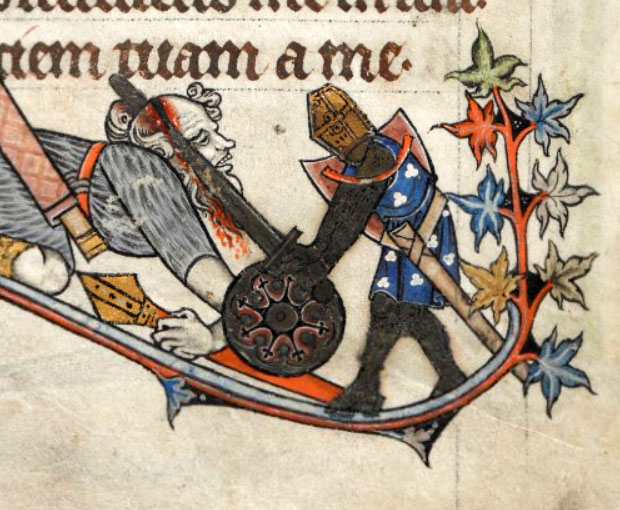Looking for examples of great swords portrayed in Medieval art.
Specifically Oakeshott Types XIIa and XIIIa.
I've already been through all the databases at Manuscript Miniatures.
Post 'em if you got 'em, with the source please.
Basically I've been looking for two-handed swords in art and paintings between AD 1250-1350. During this time the Type XVa bastard sword can be confused with XIIa and XIIIa great swords. If you can see the blade, great swords are fullered and XVa blades are diamond. Also Type XVa tend to have the down-turned Type 8 crossguard, whereas Type XIIa and XIIIa tend to have the straighter Type 1-7 guards.
Thanks
[ Linked Image ]
http://manuscriptminiatures.com/4879/13325/
[ Linked Image ]
http://manuscriptminiatures.com/4789/10036/
Last edited by Harry Marinakis on Sat 25 Jan, 2014 12:49 am; edited 3 times in total
as late as 1370 =)
http://manuscriptminiatures.com/4423/10368/
Even though it represents the Illiad, the guys seem to look pretty contemporary to me http://manuscriptminiatures.com/search/?man
http://manuscriptminiatures.com/4423/10368/
Even though it represents the Illiad, the guys seem to look pretty contemporary to me http://manuscriptminiatures.com/search/?man
| Augusto Boer Bront wrote: |
| as late as 1370 =)
http://manuscriptminiatures.com/4423/10368/ Even though it represents the Illiad, the guys seem to look pretty contemporary to me http://manuscriptminiatures.com/search/?man |
These might be XVIa's but similar enough to XIIa and probably also used similarly...
No one else has anything?
Bump!
Bump!
From our Type XIII spotlight article:
This article was written 8 1/2 years ago. Don't ask me what my exact source for that paragraph was (probably something Oakeshott published), but the perhaps text above will allow you to track these two down.
| Quote: |
| Type XIII Swords Found in Art
Many examples of this type can be found in period art, and these largely provide a dateable reference for the period of use these swords saw. A famous example is found in the Tenison psalter, made for a short-lived son of England's Edward I. In this example, the sword is clearly shown being used with two hands, while its scabbard hangs from the knight's belt. Another example comes again from England, in a manuscript dating from around 1300 called an "Apocalypse of St. John." This shows a kneeling knight girded with a long sword appearing to be a Type XIII. There are numerous sculpted examples in England, Spain and Germany, whether on effigies or other sculptures. |
This article was written 8 1/2 years ago. Don't ask me what my exact source for that paragraph was (probably something Oakeshott published), but the perhaps text above will allow you to track these two down.
http://www.myArmoury.com/talk/viewtopic.php?t...w=previous
Old thread, but relevant here. Check out Sean Flynt's post a few entires down.
Old thread, but relevant here. Check out Sean Flynt's post a few entires down.
I've noticed that often modern reproductions of Great swords (Type XIIa and XIIIa) come with a suspension that includes two or more straps. For example, here is a Hanwei/Tinker Great sword suspension:

But in Medieval art all I've been able to find are Great swords with integral scabbard & belts (see my example in my OP above and the images below). In fact, if you search for images during the period of the Great sword (AD 1250-1350) you won't find very many (if any) sword suspensions that have straps, only integrated belts & scabbards.
Do you know of any examples in art where a Great sword is suspended by straps?
I am trying to determine whether or not a strap suspension is truly an authentic way to suspend a Great sword (Type XIIa and XIIIa).
Given that (1) straps suspensions are rare AD1250-1350 and (2) I haven't found any Great swords suspended by straps, it seems that modern Great sword suspensions are not really accurate.
[ Linked Image ]
[ Linked Image ]

But in Medieval art all I've been able to find are Great swords with integral scabbard & belts (see my example in my OP above and the images below). In fact, if you search for images during the period of the Great sword (AD 1250-1350) you won't find very many (if any) sword suspensions that have straps, only integrated belts & scabbards.
Do you know of any examples in art where a Great sword is suspended by straps?
I am trying to determine whether or not a strap suspension is truly an authentic way to suspend a Great sword (Type XIIa and XIIIa).
Given that (1) straps suspensions are rare AD1250-1350 and (2) I haven't found any Great swords suspended by straps, it seems that modern Great sword suspensions are not really accurate.
[ Linked Image ]
[ Linked Image ]
That Hanwei/Tinker suspension is fiction for that period. It superficially resembles some suspensions from later times, though.
Are you agreeing with me, that Great swords were carried in integrated scabbard/belt harnesses?
Chad-
Tenison Psalter
Folio f.17.r
http://www.bl.uk/manuscripts/FullDisplay.aspx?ref=Add_MS_24686
 Attachment: 135.9 KB
Attachment: 135.9 KB

Tenison Psalter
Folio f.17.r
http://www.bl.uk/manuscripts/FullDisplay.aspx?ref=Add_MS_24686

I believe it was once noted that an integrated-belt scabbard could work for a greatsword if you wore it fairly high up, and perhaps had it set up so the scabbard was at somewhat more of a tilt. It was someone here on the board who tried this, actually, I think...
It's also possible that those who wore such swords simply developed the habit of keeping it tilted with a hand on the grip or pommel as they walked about. It would be a natural enough thing to do, I think.
Eric Norenberg-- your link leads to a thread on Viking swords, not greatswords...
It's also possible that those who wore such swords simply developed the habit of keeping it tilted with a hand on the grip or pommel as they walked about. It would be a natural enough thing to do, I think.
Eric Norenberg-- your link leads to a thread on Viking swords, not greatswords...
| Harry Marinakis wrote: |
| Are you agreeing with me, that Great swords were carried in integrated scabbard/belt harnesses? |
My statement was more disagreeing with the Tinker suspension. :)
But since you ask, I haven't seen evidence that great swords had suspensions that were substantively different from arming swords during the era in question. So yes, I think we agree. :)
Page 1 of 1
You cannot post new topics in this forumYou cannot reply to topics in this forum
You cannot edit your posts in this forum
You cannot delete your posts in this forum
You cannot vote in polls in this forum
You cannot attach files in this forum
You can download files in this forum
All contents © Copyright 2003-2006 myArmoury.com — All rights reserved
Discussion forums powered by phpBB © The phpBB Group
Switch to the Full-featured Version of the forum
Discussion forums powered by phpBB © The phpBB Group
Switch to the Full-featured Version of the forum